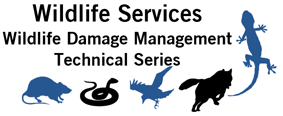United States Department of Agriculture: Animal and Plant Health Inspection Service

Wildlife Damage Management Technical Series
Date of this Version
1-2018
Document Type
Article
Citation
Miller, J.E. 2018. Muskrats. Wildlife Damage Management Technical Series. USDA, APHIS, WS National Wildlife Research Center. Fort Collins, Colorado. 13p.
Abstract
The muskrat (Ondatra zibethicus) is a common, semi-aquatic rodent native to the United States (Figure 1). It spends its life in aquatic habitats and is well adapted for swimming.
Although muskrats are an important part of native ecosystems, their burrowing and foraging activities can damage agricultural crops, native marshes and water control systems, such as aquaculture and farm ponds and levees. Such damage can significantly impact agricultural crops like rice that rely on consistent water levels for growth.
Muskrats also cause damage by eating agricultural crops, other vegetation, and crayfish, mussels and other aquaculture products. Loss of vegetation from muskrat foraging can impact marsh viability and habitats for other species, including waterfowl. Habitat restoration often takes years, negatively impacting fish and wildlife.
Economic losses due to muskrat damage in Arkansas, California, Louisiana and Mississippi likely exceed most other states combined, primarily because of the vast amounts of productive marshlands and types of crops (i.e., rice, fish, crayfish and vegetable crops) grown in those states.
The 16 subspecies of Ondatra muskrats in North America are widely distributed (Figure 6). They are found from northern Mexico to northern Alaska, and most of northern Canada. The round-tailed muskrat is found primarily in Florida and parts of southern Georgia. Muskrats are not commonly found in dryer, desert type habitats.
Included in
Behavior and Ethology Commons, Biodiversity Commons, Other Animal Sciences Commons, Other Ecology and Evolutionary Biology Commons, Population Biology Commons, Terrestrial and Aquatic Ecology Commons


Comments
US government work.